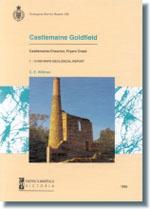GSV Report 106 - Castlemaine goldfield - Castlemaine-Chewton, Fryers Creek 1:10 000 map areas geological report
 |
| |||||||||||||||||||||||||||||
Product description:Download The downloadable version of this report is supplied in PDF format and is a large file (29.4MB). Abstract This report describes the geology of the area covered by the Castlemaine-Chewton and Fryers Creek 1:10,000 geological maps. The history of mining, geological history and physiography are described together with detailed descriptions of the Lower Ordovician turbidites and the Tertiary to Quaternary auriferous fluviatile gravels. Gold-quartz mineralisation is given strong emphasis and detailed gold production statistics from 1864 to 1993 are presented. Cross-sections depicting the mineralised structures from some major mines are illustrated. The Castlemaine goldfield has produced at least 173 tonnes (5.56 million ounces) of gold from primary quartz veins and secondary alluvial deposits since its discovery in 1851. The area was known mainly as an alluvial field in the 19th century but the reopening of the Wattle Gully mine in 1933 shifted focus to the rich reef deposits. The bedrock of the area is a Lower Ordovician turbidite sequence (Castlemaine Supergroup) which is subdivided into biostratigraphic units based on an excellent graptolite fauna preserved mainly in interbedded black shales. About 1600 m of the sequence is exposed in the Castlemaine goldfield. There are no easily identifiable lithological units or formations which can be followed by mapping. The turbidites formed in a channellised and braided marine fan or basin plain, marginal to a granitic and metamorphic source terrain. The Castlemaine Supergroup was folded in the Early Silurian Benambran Deformation into a set of closely spaced north-south trending chevron folds associated with low grade greenschist facies regional metamorphism and strong cleavage development. Two major structural domains are defined largely on the basis of their fold geometry. The Goldfield Structural Domain is characterised by a sub-horizontal enveloping surface and relatively symmetrical folds. The domain represents the culmination of a regional anticlinorium. All of the gold-quartz mineralisation is contained within this domain. The Eastern Structural Domain is characterised by asymmetric folds, a west-dipping enveloping surface and an eastward intensification of cleavage. Except for a few minor deposits, it is non-auriferous. Gold-quartz mineralisation occurs as narrow vein style deposits hosted by the deformed Castlemaine Supergroup. At the mine scale mineralisation is controlled by bedding, folds and faults and is associated with weak wall rock alteration. On a regional scale most deposits are located within four narrow north-south trending zones. These zones are interpreted as the outcrop of weakened second-order splay faults that are structurally related to major faults. In the main Fryerstown-Chewton zone, deposits are aligned along the east-dipping limbs of two major anticlines. Individual deposits in this zone are either directly related to west-dipping faults or occur as concentrated zones of sub-horizontal quartz veins interpreted to be the along-strike extensions of fault-related shear zones. Quartz vein morphology is an indicator of the style of progressive deformation. Laminated quartz occurs in bedding-parallel structures which formed during the early stages of deformation, mainly by a process of flexural slip. Massive and laminated quartz veins, which occur within and adjacent to strike faults, formed late during deformation. Sets of sub-horizontal extensional quartz veins ("spurs") occur in shear zones which formed during the growth of strike faults late during deformation. Most gold production was derived from west-dipping fault related structures and associated "spurs". Saddle reefs are poorly developed at Castlemaine. The Harcourt Granodiorite intruded the already deformed and mineralised Lower Ordovician sequence in the Late Devonian and produced a 1.3 km wide contact metamorphic aureole. In the Late Jurassic, lamprophyre dykes intruded anticline hinges during regional extensional tectonism. At least three major cycles of fluviatile sedimentation have reworked and concentrated gold into alluvial gravels. The White Hills Gravel and Calivil Formation are Tertiary in age and occur as isolated hill top deposits. The Quaternary Shepparton Formation fills the present drainage system. Non-metallic resources include clay, slate, sandstone and gravel. Bibliographic reference Willman, C.E., Castlemaine Goldfield - Castlemaine-Chewton, Fryers Creek 1:10 000 maps geological report. Geological Survey of Victoria Report 106. Related products:
| ||||||||||||||||||||||||||||||



